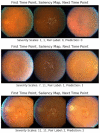LONGL-Net: temporal correlation structure guided deep learning model to predict longitudinal age-related macular degeneration severity
- PMID: 35360552
- PMCID: PMC8962776
- DOI: 10.1093/pnasnexus/pgab003
LONGL-Net: temporal correlation structure guided deep learning model to predict longitudinal age-related macular degeneration severity
Abstract
Age-related macular degeneration (AMD) is the principal cause of blindness in developed countries, and its prevalence will increase to 288 million people in 2040. Therefore, automated grading and prediction methods can be highly beneficial for recognizing susceptible subjects to late-AMD and enabling clinicians to start preventive actions for them. Clinically, AMD severity is quantified by Color Fundus Photographs (CFP) of the retina, and many machine-learning-based methods are proposed for grading AMD severity. However, few models were developed to predict the longitudinal progression status, i.e. predicting future late-AMD risk based on the current CFP, which is more clinically interesting. In this paper, we propose a new deep-learning-based classification model (LONGL-Net) that can simultaneously grade the current CFP and predict the longitudinal outcome, i.e. whether the subject will be in late-AMD in the future time-point. We design a new temporal-correlation-structure-guided Generative Adversarial Network model that learns the interrelations of temporal changes in CFPs in consecutive time-points and provides interpretability for the classifier's decisions by forecasting AMD symptoms in the future CFPs. We used about 30,000 CFP images from 4,628 participants in the Age-Related Eye Disease Study. Our classifier showed average 0.905 (95% CI: 0.886-0.922) AUC and 0.762 (95% CI: 0.733-0.792) accuracy on the 3-class classification problem of simultaneously grading current time-point's AMD condition and predicting late AMD progression of subjects in the future time-point. We further validated our model on the UK Biobank dataset, where our model showed average 0.905 accuracy and 0.797 sensitivity in grading 300 CFP images.
Keywords: Generative Adversarial Networks; age-related macular degeneration; deep learning; longitudinal outcome prediction.
© The Author(s) 2022. Published by Oxford University Press on behalf of the National Academy of Sciences.
Figures






References
-
- Bird AC, et al. . 1995. An international classification and grading system for age-related maculopathy and age-related macular degeneration. Surv Ophthalmol. 39(5):367–374. - PubMed
-
- Trucco E, MacGillivray T, Xu Y. 2019. Computational retinal image analysis: tools, applications and perspectives. Cambridge, MA: Academic Press.
-
- Congdon N, et al. 2004. Causes and prevalence of visual impairment among adults in the United States. Arch Ophthalmol. 122(4):477–485. - PubMed
Grants and funding
LinkOut - more resources
Full Text Sources
Miscellaneous

